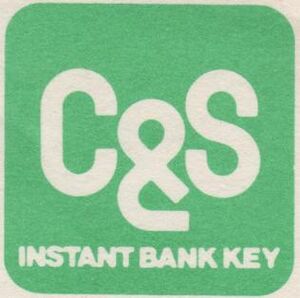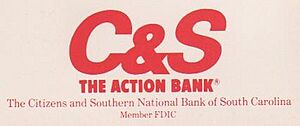- This page was last modified on 17 October 2025, at 10:18. Suggest an edit.
Citizens & Southern National Bank facts for kids
Citizens and Southern National Bank (often called C&S) was a big American bank. It started in Georgia and grew to include South Carolina and Florida. For much of the 1900s, it was the largest bank in the southeastern United States.
C&S later joined with other banks. In 1990, it merged with Sovran Bank to create C&S/Sovran. This was done to try and stop another bank, NCNB Corporation, from taking them over. However, just one year later, C&S/Sovran merged with NCNB. This new company was called NationsBank. Today, NationsBank is a main part of the much larger Bank of America.
One of its former locations in Charleston, South Carolina, is a very old bank building. It was built in 1798 as the Bank of South Carolina. It might be the oldest building in the U.S. still used as a bank. C&S bought this historic building in 1966. It is now a private office building.
Contents
The Bank's Beginning
The C&S bank started in Georgia. It was formed in 1906 when two banks in Savannah, Georgia, joined together. These were the Citizens Bank (started in 1887) and the Southern Bank of Georgia.
A key person in this early history was Mills B. Lane. He became president of Citizens Bank in 1901. In 1906, he helped bring the two banks together. The new bank was officially named the Citizens and Southern Bank of Georgia.
In 1922, Citizens and Southern also took over Central Bank and Trust Corp. This bank was founded by Asa Griggs Candler, who also helped start Coca-Cola.
C&S received permission to open offices in South Carolina in 1927. Mills Lane Jr. and Hugh C. Lane were very important to the bank's growth. Mills Lane Jr. led C&S from 1946 to 1973. During this time, he made it the biggest and most successful bank in the South.
In South Carolina, C&S of Georgia bought two banks in Charleston. These were Atlantic Savings Bank and Atlantic National Bank. In 1928, these banks were renamed Citizens and Southern Bank of South Carolina.
Growing Apart and Coming Back Together
Both the Georgia and South Carolina parts of C&S grew quickly. In 1940, new government rules stopped banks from operating in many states at once. Because of this, C&S of South Carolina became its own separate company. This allowed South Carolina to have its own large "local" bank.
In 1960, C&S of South Carolina started using computers. This made banking easier and faster. They even offered free checking accounts to customers who kept at least $100 in their account. This was a new idea in South Carolina!
In 1985, the Citizens and Southern Georgia Corporation bought Citizens and Southern National Bank of South Carolina. This brought the two banks back together in 1986. When they reunited, the South Carolina bank had $2.5 billion in assets. The Georgia bank had $12.3 billion.
C&S of Georgia also bought Landmark Banks of Florida in 1985. This bank became The Citizens & Southern National Bank of Florida. These purchases helped C&S of Georgia double its size in just 18 months.
Big Bank Mergers
From 1984 to 1986, a special rule allowed banks in the Southern states to buy each other. This helped them grow bigger and stronger. They wanted to avoid being taken over by even larger banks from other parts of the country.
Joining with Sovran Financial Corp.
In 1988, another bank called NCNB started trying to buy C&S. To protect itself, C&S decided to merge with Sovran Bank from Norfolk, Virginia. The new company was named C&S/Sovran. It had two main offices, one in Atlanta and one in Norfolk.
This merger created a huge bank with branches in many states. It seemed like it would be strong enough to resist any takeover attempts.
Becoming NationsBank
However, the quick merger of C&S and Sovran had some problems. There were disagreements between the leaders from the two original banks. Also, Sovran had some loans that were not doing well. These issues made C&S/Sovran weaker.
NCNB saw that C&S/Sovran was having trouble. NCNB had also been growing by buying other banks. In 1991, NCNB bought the weakened C&S/Sovran. The new company was named NationsBank. Its main office was in Charlotte.
Before this merger, NCNB was the 10th largest bank in the U.S. C&S/Sovran was 12th. After they joined, NationsBank became the 3rd largest bank in the country!
As part of the merger, some C&S branches were sold to other banks. For example, several C&S branches in South Carolina were sold to First Citizens Bank.
NationsBank continued to grow even more. It eventually bought BankAmerica Corp.. Even though NationsBank was the company that survived, it decided to use the more famous name, Bank of America.
Headquarters Buildings
C&S had two main headquarters buildings in Atlanta after it grew from Savannah.
The first building is still standing today. It is now part of Georgia State University. This building was built in 1901 and was Atlanta's first steel-framed building. It was known as the Citizens and Southern National Bank Building from 1929 to 1992. After C&S was bought by NCNB, the building was given to the university.
In 1968, C&S moved its main office to a new building called the C&S Bank Tower. This building had a very unique design for Atlanta at the time.
The C&S Bank Tower building was carefully taken apart piece by piece. This happened after a new, much larger building opened in 1992. This new building was started by C&S before its mergers. It opened as NationsBank Plaza. Later, after NationsBank merged with BankAmerica, it was renamed Bank of America Plaza.


